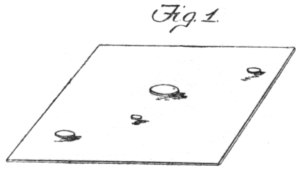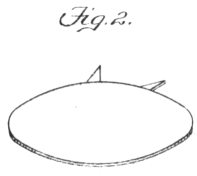
| Contents etc. | The History of Astria |
PLACING some coins on the table one day, I amused myself by pushing them about, and it struck me that one might represent a planetary system of a certain sort by their means. This large one in the centre represents the sun, and the others its planets journeying round it.

And in this case considering the planets as inhabited worlds, confined in all their movements round their sun, to a slipping over the surface of the table, I saw that we must think of the beings that inhabit these worlds as standing out from the rims of them, not walking over the flat surface of them. Just as attraction in the case of our earth acts towards the centre, and the centre is inaccessible by reason of the solidity on which we stand, so the inhabitants of my coin worlds would have an attraction proceeding out in every direction along the surface of the table from the centre of the coin, and "up" would be to them out from the centre beyond the rim, while "down" would be towards the centre inwards from the rim: And beings thus situated would be rightly described as standing on the rim.

And I saw that if I supposed the surface of the table to be perfectly smooth, so that there was no impediment to motion along it, then these beings would have no notion at all that there was a surface on which they slipped. Since the surface is always in contact with every moving thing, the notion of it would be absent from their consciousness. There would be no difference in respect to it. And I saw that here I had an image of a two dimensional world, a world in which the creatures of it would think that space itself was two dimensional.
We see that the discs which form these worlds must be supported somehow, but the beings of such a universe would not ask such a question—they would think that all the space there was lay in the extension of the movements they made, and would never think of any movement away from or into the table, being always in contact with it.
But it is very hard to realise how "out" from a disc, such as one of my coins, could be felt as "up" and inward towards the centre of it would be felt as "down." To ease my mind on this point I imagined myself standing on the equator of our earth, looking along it, and then a great steel blade coming down and cutting the earth right through along the equator circle, and thencoming down again and cutting a slice parallel to the first. And then I imagined this slice of the earth and myself sticking against the steel blade, like the slice of a pea against a knife blade. In this way I gained the feeling of a being on a disc, with an "up and down," "away from and to" the centre of the disc.
But still I had a consciousness of another direction than those of "forward and backward"—along the rim of the disc—and "up and down" away from its centre and towards it. I could not help predicating myself with the sense of right and left—away from and into the steel blade. To lose this sense I must evidently change my notion of the constitution of my body. Without carrying the cutting so far as to imagine myself sliced, I imagined myself as made of very thin material, just of the width of the slice of the earth, and supposed that I myself and all the matter of the slice were of the same thickness, and stood out from the blade to exactly the same amount.
"If now," I said, "I was unconscious of this thickness, if the blade was perfectly smooth, and I and all the matter I knew slipped perfectly freely over it, I should have a two dimensional experience. My arm in moving, or my finger in pointing, could only move in contact with the blade, and I could never point in a third dimension. I should not think of it, for all motions of all things take place along the surface of the blade."
Thus it became apparent that without making the supposition that I was a mere line or triangle, or other geometrical figure, I could imagine myself as a two dimensional being. If my thickness were very small and I was unconscious of it, if I could never move away from contact with a surface, my experience would be that of a two dimensional being. So, after all, it seemed possible that there could be real two dimensional beings. Now, if a thing is real, the only reason for not seeing it is either that it is small, or very far away—or some other reason. Hence I began to set about to try to discover these two dimensional beings, and learn all about them. I succeeded at last, and if I do not tell you how, I am afraid it is from no very worthy motive. For if I told how one could find out about them, I am afraid Mr. Wells or Mr. Gelett Burgess or some other brilliant author would begin to write about them, and to serve them up with all the resources of wit and humour. In that case no one would listen to me. As it is I intend to have the pleasure of telling about them myself.
One thing always puzzled me from the beginning of the time when I began to think about these plane beings, and that is about their eyes.
It is clear that they could not have two eyes beside one another as we have, for there is not the thickness in their bodies to place them so. Now, if they had two eyes, I wondered if one was above the other, or if they had one eye in front, another in the back of their heads. About this and other questions, I gained subsequently all the information one can desire. I have come to think of these creatures, from what I have found out, as very like ourselves, in different physical conditions it is true—but motives, aims and character, vary but little, however conditions differ. The only broad characteristic of difference I would draw, is that they are not so massive as we. They are more easily moved to action, and political and other changes are brought to pass more easily than with us. They also take narrower views than we do, they do not look on things in the broad and tolerant way we do.
In order to place before the reader all that I have to say systematically, I will begin with a short history of Astria, summarising the events which took place on that planet from the earliest times till I come to the epoch about which I have written in mere detail. With regard to that period, by selecting from the materials at my disposal, I have given some definite and personal information about characters who played an important part in late events.
| Contents etc. | The History of Astria |